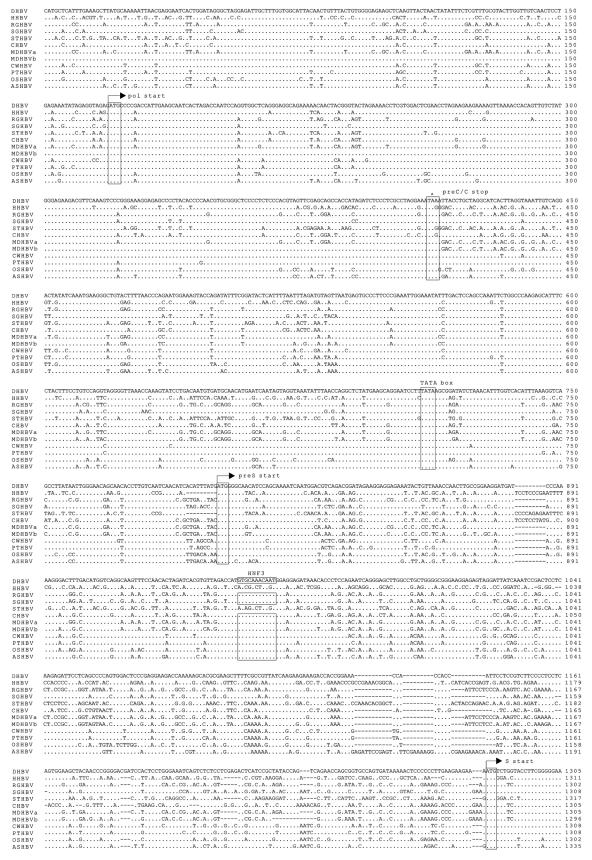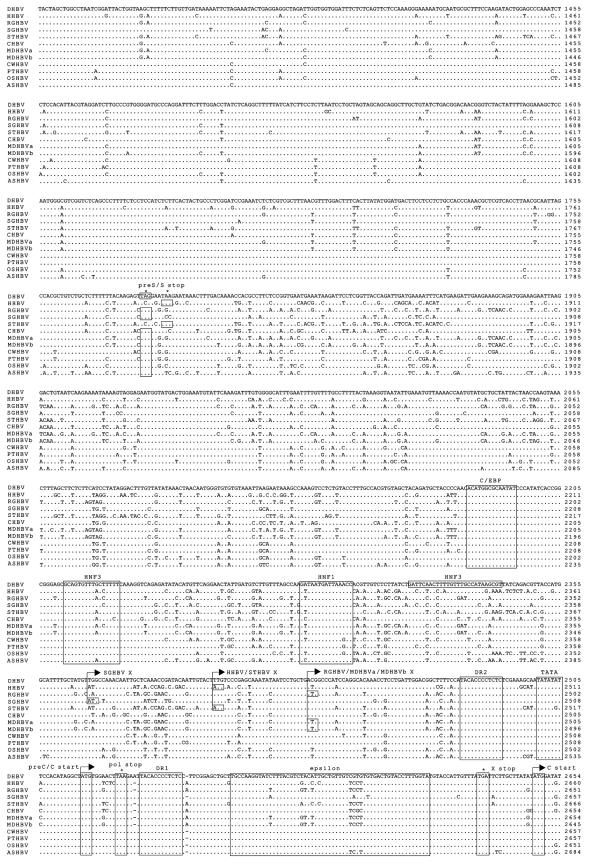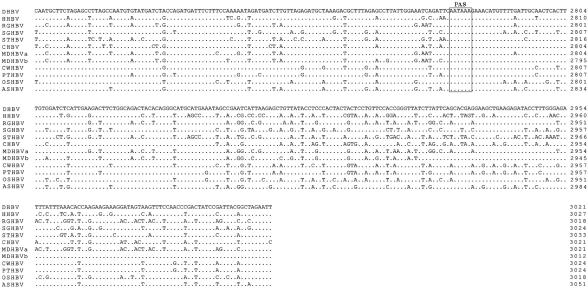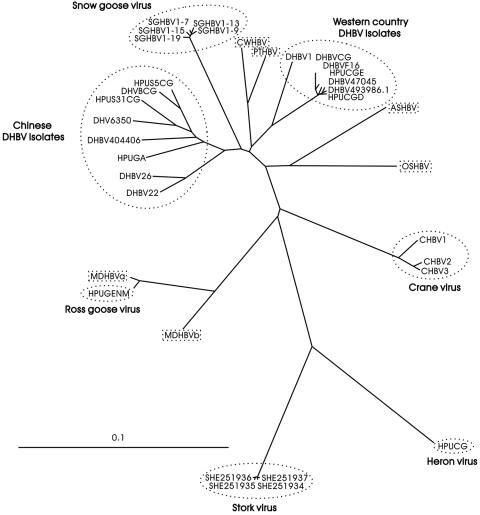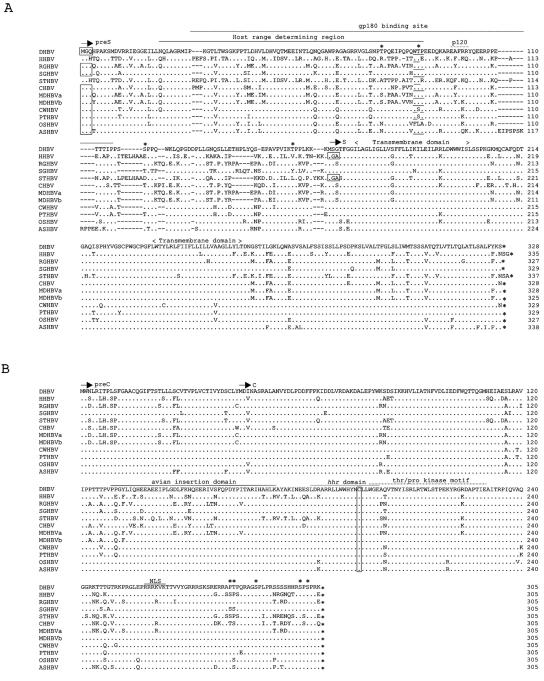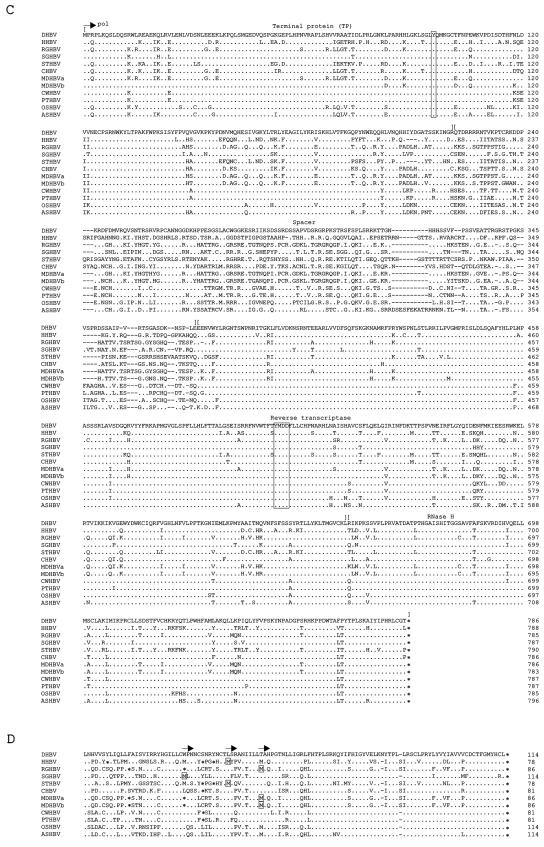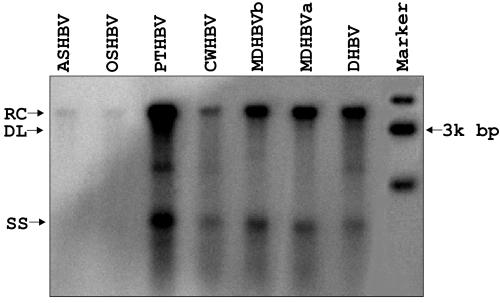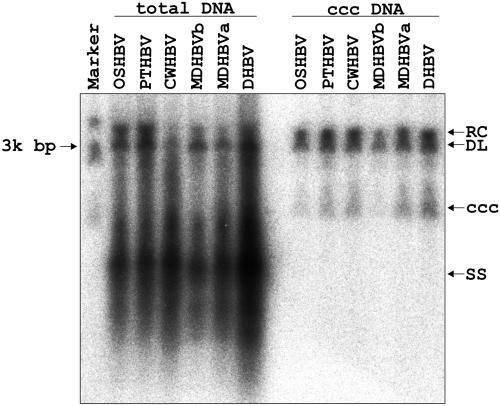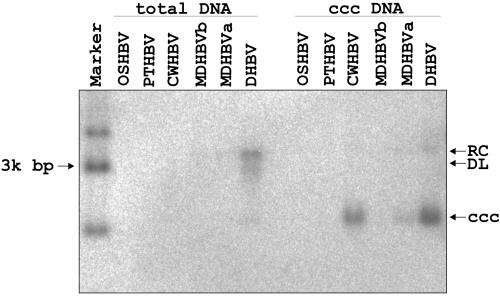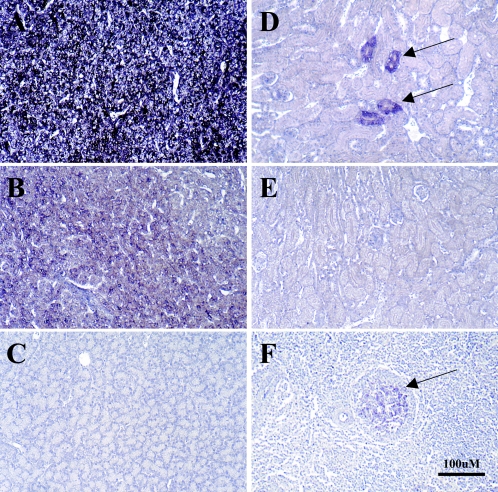Abstract
Five new hepadnaviruses were cloned from exotic ducks and geese, including the Chiloe wigeon, mandarin duck, puna teal, Orinoco sheldgoose, and ashy-headed sheldgoose. Sequence comparisons revealed that all but the mandarin duck viruses were closely related to existing isolates of duck hepatitis B virus (DHBV), while mandarin duck virus clones were closely related to Ross goose hepatitis B virus. Nonetheless, the S protein, core protein, and functional domains of the Pol protein were highly conserved in all of the new isolates. The Chiloe wigeon and puna teal hepatitis B viruses, the two new isolates most closely related to DHBV, also lacked an AUG start codon at the beginning of their X open reading frame (ORF). But as previously reported for the heron, Ross goose, and stork hepatitis B viruses, an AUG codon was found near the beginning of the X ORF of the mandarin duck, Orinoco, and ashy-headed sheldgoose viruses. In all of the new isolates, the X ORF ended with a stop codon at the same position. All of the cloned viruses replicated when transfected into the LMH line of chicken hepatoma cells. Significant differences between the new isolates and between these and previously reported isolates were detected in the pre-S domain of the viral envelope protein, which is believed to determine viral host range. Despite this, all of the new isolates were infectious for primary cultures of Pekin duck hepatocytes, and infectivity in young Pekin ducks was demonstrated for all but the ashy-headed sheldgoose isolate.
Hepadnaviruses are small, enveloped DNA viruses that replicate via reverse transcription of an RNA pregenome. The family Hepadnaviridae is divided into two genera, Orthohepadnavirus and Avihepadnavirus, each with restricted host specificity. Ortho (mammalian) hepadnaviruses have been found in humans (hepatitis B virus [HBV]) and great apes, woolly monkeys (woolly monkey HBV), woodchucks (woodchuck hepatitis virus), ground squirrels (ground squirrel hepatitis virus), arctic squirrels (arctic squirrel hepatitis virus), and Richardson ground squirrels (Richardson ground squirrel hepatitis virus). The avian hepadnaviruses include duck HBV (DHBV) (40, 43, 58, 66), heron HBV (HHBV) (52), Ross goose HBV (RGHBV; GenBank accession no. M95589), snow goose HBV (SGHBV) (11), stork HBV (STHBV) (50), and crane HBV (CHBV) (48).
Sequence similarities between the ortho- and avihepadnaviruses are minimal except in highly conserved functional domains, though the overall genome organization is similar. Proteins encoded by both groups include the nucleocapsid (core) and envelope polypeptides (L and S), the nonstructural HBeAg (a secretory protein of unknown function), and the polymerase/reverse transcriptase protein (Pol protein). Orthohepadnaviruses also encode a third envelope protein, M, and a regulatory protein, termed X, that is required for efficient replication in vivo (13, 65, 67). Studies with liver cell lines suggest that X stimulates signal transduction, regulates several transcription factors, and has a role in virus replication, though the relationship between these observations and the role of X in vivo remains elusive (3, 5-7). Recently, expression of an X-like protein from an open reading frame (ORF) on the DHBV genome lacking a conventional start codon was reported (12, 27). An ORF is also present in the same location on other avihepadnavirus genomes; however, whether X-like proteins are expressed during natural infections by all of these avihepadnaviruses is unknown. Expression of the DHBV X-like protein in cell culture led, as with the HBV X protein, to transcriptional activation of several heterologous promoters (12). However, a knockout mutation in the X ORF did not alter the ability of DHBV either to replicate in culture or to induce transient and persistent infections in ducks (12, 44), and the relevance of the transcriptional activation data remains unclear.
All known hepadnaviruses are hepatotropic and cause transient and persistent infections with variable degrees of pathogenesis (51). Infection is limited to the species from which a virus has been isolated or to closely related species. It is generally believed that host range and tissue restriction are regulated at the level of virus entry, specificity being determined by the pre-S1 domain of the L envelope protein of the orthohepadnaviruses and the homologous pre-S domain of the avihepadnaviruses. Between hepadnaviruses, this domain is the most divergent region of the viral envelope, consistent with a role in species-specific receptor recognition. This idea is supported by a report that replacement of a small region (69 amino acids) of the HHBV-specific pre-S domain by the corresponding DHBV domain facilitated infection of duck hepatocytes, which are not otherwise susceptible to HHBV (20). Similarly, exchange of as little as 9 amino acids of the pre-S1 domain of HBV with corresponding sequences from woolly monkey HBV reduced infectivity for human hepatocytes (14). Carboxypeptidase D (gp180) has been identified as a possible receptor for DHBV (8, 28, 29, 57), mediating virus attachment and internalization. Unfortunately, transfection of nonpermissive cells with gp180 does not confer susceptibility to DHBV, indicating that additional, or other, cellular factors are involved in host range determination during or subsequent to virus attachment and entry (32, 48, 51).
As an approach to determining the significance of pre-S variation in viral host range determination and evaluating the possibility that the X ORF is conserved throughout the avihepadnavirus genus, which may argue for a functional role, we cloned, sequenced, and evaluated the infectivity in Pekin ducks (Anas domesticus) of a number of new viruses identified in anseriforme birds maintained in aviculture collections. Serum samples taken from exotic ducks and geese were screened by DNA hybridization for DHBV-related genomes. New hepadnavirus isolates were detected in the mandarin duck, Chiloe wigeon, puna teal, Orinoco sheldgoose, and ashy-headed sheldgoose. These have been designated mandarin duck HBVa and b (MDHBVa and MDHBVb, differing slightly in sequence and isolated from a male and female mandarin duck from different aviculture collections, respectively), Chiloe wigeon HBV (CWHBV), puna teal HBV (PTHBV), Orinoco sheldgoose HBV (OSHBV), and ashy-headed sheldgoose HBV (ASHBV). All isolates differed significantly from DHBV in pre-S. Nonetheless, all primary isolates were able to infect the mallard (J. E. Newbold, unpublished data), the species from which most domesticated ducks are derived, and all of the cloned isolates but ASHBV were shown to infect the Pekin duck. Sequence comparisons provided evidence of an X-like ORF, beginning with an AUG start codon, in some but not all of these virus isolates, and ending at the same stop codon. Full genome sequence alignments and comparisons suggested that the Mandarin duck and Ross goose viruses are closely related and possibly define a new species within the avihepadnavirus genus, a decision that will ultimately require characterization of these viruses, in comparison to DHBV, in their natural hosts.
MATERIALS AND METHODS
Serum samples.
Sera containing DHBV-related viruses were collected from two mandarin ducks (genus Aix, male and female) from two different aviculture collections in North Carolina, two Chiloe wigeons, probably siblings (genus Anas, male and female), from an aviculture collection in Ohio, a puna teal (genus Anas) from an aviculture collection in Pennsylvania (original serum sample passed once in a domestic mallard to expand the stock), an Orinoco sheldgoose (genus Neochen) from an aviculture collection in North Carolina (original serum passed once in a paradise shelduck to expand the stock), and an ashy-headed sheldgoose (genus Chloephaga) from an aviculture collection in North Carolina.
Screening for DHBV-related viruses via hybridization spot test.
Hybridization spot tests for DHBV-like virus in serum samples was carried out as previously described (42).
Cloning of viral genomic DNA.
Serum (300 μl) from each bird containing a DHBV-related virus was layered on a 10 to 20% (wt/vol) sucrose step gradient in 0.15 M NaCl-0.02 M Tris-HCl (pH 7.4) and centrifuged at 45,000 rpm in a Beckman SW60 rotor for 3 h at 4°C. The virus pellet was suspended in 100 μl of 0.2% (wt/vol) sodium dodecyl sulfate (SDS)-1 mg of pronase/ml, 0.015 M Tris-HCl (pH 7.5), and 0.01 M EDTA and incubated at 37°C for 1 h. The nucleic acids were extracted twice with an equal volume of phenol-chloroform (1:1), and the supernatant was precipitated with 2 volumes of ethanol with addition of 20 μg of dextran as carrier. The pellet was washed with 70% ethanol, dried, and resuspended in 20 μl of TE (10 mM Tris-HCl [pH 7.4], 1 mM EDTA). The virus DNA was cleaved with XbaI or, for MDHBV, EcoRI, and ligated into the respective site of the lambda ZAP II vector (Stratagene). The bacteriophage DNA was packaged in vitro, and viral DNA-containing plaques were identified by hybridization (2). The entire insert from bacteriophage lambda DNA was released with XbaI or EcoRI, as appropriate, and cloned into the corresponding site of plasmid pGEM-3Z (Promega). For MDHBVb and OSHBV, due to poor growth of the lambda clones of these viruses, the cloned viral genomes were amplified from the bacteriophage by using the Advantage-HF 2 PCR kit (Clontech) with the M13fwd and M13rev primers and then cloned into pGEM-3Z. Head-to-tail dimer clones of the complete viral genomes were used for transfection studies.
Initial analyses revealed that the clones of mandarin duck, Chiloe wigeon, puna teal, and Orinoco sheldgoose were full length (∼3 kbp). The ashy-headed sheldgoose clone was only 2,451 nucleotides in length, due to the loss of an XbaI fragment (∼600 bp) present within the core gene region. This XbaI fragment was amplified by using the Advantage-HF 2 PCR kit (Clontech) from serum-derived viral DNA and ligated to the 2,451-bp XbaI fragment in the pGEM-3Z plasmid to produce a full-length genome.
DNA sequencing of cloned avihepadnavirus genomes.
Both strands of each cloned virus genome were sequenced by using an ABI PRISM 377 automated sequencing system. Plasmid DNA was extracted and purified by using a Midiprep kit (QIAGEN). The nucleotide sequence data for the six distinct avihepadnaviruses (MDHBVa, MDHBVb, CWHBV, PTHBV, OSHBV, and ASHBV) were deposited in GenBank (see “Nucleotide sequence accession number” below). The isolates from the two Chiloe wigeons were identical in sequence.
Comparative sequence analysis of avihepadnaviruses.
The relationship of the new avihepadnaviruses to the known avian hepadnaviruses was investigated by phylogenetic analysis by using the ClustalX, version 1.81, and TreeView, version 1.6.6, programs as described previously (47, 55). Other avihepadnavirus sequences were obtained from GenBank as follows (accession numbers are indicated in parentheses): Western country DHBV isolates, DHBV1 (X58567), DHBVF16 (X12798), DHBVCG (X74623), HPUCGE (M60677), HPUCGD (K01834), DHBV493986.1 (AF493986), DHBV47045 (AF047045), DHBV26 (X58569), DHBV22 (X58568); Chinese DHBV isolates, HPUGA (M21953), DHBV404406 (AF404406), HPUS5CG (M32990), DHVBCG (X60213), HPUS31CG (M32991); Australian DHBV isolate, DHV6350 (AJ006350); SGHBV isolates, SGHBV1-7 (AF110999), SGHBV1-9 (AF111000), SGHBV1-13 (AF110996), SGHBV1-15 (AF110997), SGHBV1-19 (AF110998); RGHBV isolate, HPUGENM (M95589); STHBV isolates, SHE251934 (AJ251934), SHE251935 (AJ251935), SHE251936 (AJ251936), SHE251937 (AJ251937); HHBV, HPUCG (M22056); CHBV isolates, CHBV1 (AJ441111), CHBV2 (AJ441112), CHBV3 (AJ441113).
Cell culture and transfection.
The chicken hepatoma cell line LMH (25) was grown at 37°C on 60-mm-diameter tissue culture dishes in 1:1 Dulbecco's minimal essential medium-Ham's nutrient mixture F-12 supplemented with 10 mM NaH2CO3 and 10% calf serum. Transfection of purified plasmid DNA (5 μg) was performed by using Lipofectamine 2000 reagent (Invitrogen) when cultures were 70 to 80% confluent. The medium was changed daily until harvest, at which time the medium was clarified to remove floating cells and cell debris and stored at −80°C. The monolayers were rinsed twice with chilled phosphate-buffered saline (PBS) and used for intracellular core particle DNA isolation.
Isolation and analysis of viral DNA from transfected cells and culture supernatants.
Viral DNA replication intermediates were isolated from cytoplasmic nucleocapsids 5 days posttransfection as described previously (10). Viral DNA in secreted, enveloped virus particles was extracted and purified from 400 μl of clarified culture fluids by using a published method (31). Viral DNAs were subjected to electrophoresis through a 1.5% agarose gel and analyzed by Southern blotting (15) with [32P]TTP-labeled DNA probes representing the entire DHBV genome. The relative efficiency of hybridization of this probe to the other viruses was 30 to 50% when tested against the full-length cloned DNAs.
PDH infection and viral DNA analysis.
Primary duck hepatocyte (PDH) cultures were prepared from 1-week-old DHBV-negative Pekin ducklings (49). PDH were plated onto 60-mm-diameter tissue culture dishes in L15 medium supplemented with 5% fetal calf serum and maintained at 37°C. The next day, the cultures were shifted to serum-free medium L15. The cells were infected on day 2 after seeding with approximately 1.5 × 107 enveloped virus particles purified from the supernatants of transfected LMH cells. The concentration and titration of enveloped virus particles produced following transfection of LMH cells was performed as described previously (31). After 16 h, medium was replaced and changed daily thereafter. Cultures were harvested at 10 days postinfection. The plates were washed once with PBS, and viral core DNA was extracted and analyzed by Southern blotting (49).
Duck infection experiments.
One hundred microliters of virus stock purified from the supernatants of transfected LMH cells and containing 6 × 107 (MDHBVa, MDHBVb, CWHBV, and PTHBV) or 1.5 × 107 (OSHBV and ASHBV) genome equivalents of enveloped viral particles, as measured by the procedure of Lenhoff and Summers (31), were inoculated into groups of 3-day-old DHBV-negative ducks by intraperitoneal injection. Two groups of ducklings were injected with the two different amounts of DHBV to serve as positive controls. Ducks were monitored by a weekly spot test for viremia. Tissue samples (liver, pancreas, spleen, and kidney) were dissected and divided into pieces that were either snap-frozen in liquid N2 for total DNA and covalently closed circular DNA (cccDNA) extraction or fixed in ethanol-acetic acid (EAA) (3:1) for in situ hybridization (23). EAA fixation was performed at room temperature for 30 min, followed by treatment in chilled (−20°C) 70% ethanol overnight. The tissues were then dehydrated, embedded in paraffin wax, and sectioned onto gelatin-coated slides. Viral nucleic acids were detected in sections of EAA-fixed liver, spleen, kidney, and pancreas tissues by in situ hybridization with a genome-length DHBV DNA probe labeled with digoxigenin-UTP by using a nick translation kit (Roche Applied Science). The vector backbone was used as a negative control. Section preparation and detection was as previously described (21, 23). Sections were counterstained with hematoxylin and mounted in 25% glycerol in PBS.
One-day-old ducklings were purchased from Metzer Farms, Gonzales, Calif. All experiments were reviewed and approved by the Institutional Animal Care and Use Committee of the Fox Chase Cancer Center.
Total and cccDNA extraction from duck tissues.
One hundred milligrams of duck liver and spleen tissue was homogenized in 1.5 ml of ice-cold TE (10:10) buffer (10 mM Tris-HCl [pH 7.5], 10 mM EDTA) with 25 to 30 strokes of a Dounce homogenizer and divided into two aliquots for cccDNA and total DNA extractions, respectively, as described previously (53), with some modifications. Nuclear counts in the homogenates were determined, after staining with ethidium bromide, by using a hemocytometer under fluorescent illumination. Total DNA was extracted from 0.7 ml of homogenate, initially diluted to 3 ml with TE (10:10), and digested with an equal volume of pronase-SDS solution (final concentrations, 4 mg of pronase per ml, 0.5% SDS, 0.1 M NaCl, 50 mM Tris-HCl [pH 7.5], 20 mM EDTA) at 37°C for at least 2 h. The total DNA was phenol-chloroform extracted, ethanol precipitated at −20°C overnight, washed with 70% ethanol, and redissolved in 400 μl of TE (10:1). The cccDNA was extracted from the remaining 0.7 ml of liver homogenate by increasing the volume to 3 ml with TE (10:10) and then mixing with 0.2 ml of 10% SDS, followed by incubation at room temperature (RT) for 5 min. One milliliter of 2.5 M KCl was then added, and the mixture was incubated at RT for 30 min, followed by centrifugation at 10,000 rpm for 20 min at 4°C in a small SA600 rotor. The cccDNA in the supernatant was then phenol-chloroform extracted, ethanol precipitated overnight at RT, washed with 70% ethanol, and redissolved in 100 μl of TE (10:10). Samples of total DNA isolated from 1.6 × 106 liver cells and 1.2 × 106 spleen cells and cccDNA isolated from 3.2 × 106 liver cells or 4.8 × 106 spleen cells were subjected to agarose gel electrophoresis followed by Southern blot hybridization (23).
Nucleotide sequence accession number.
The nucleotide sequence data for MDHBVa, MDHBVb, CWHBV, PTHBV, OSHBV, and ASHBV were deposited in GenBank under accession numbers AY494848, AY494849, AY494850, AY494851, AY494852, and AY494853, respectively.
RESULTS
Detection of DHBV-related avihepadnaviruses in serum samples.
Serum samples were collected from ducks and geese of the anseriforme family Anatidae. DHBV-related viruses were detected in the serum of 2 mandarin ducks (genus Aix, male and female), 2 Chiloe wigeons (genus Anas, male and female), a puna teal (genus Anas), an Orinoco sheldgoose (genus Neochen), and an ashy-headed sheldgoose (genus Chloephaga). These DHBV-related viruses are here designated MDHBVa (male mandarin duck), MDHBVb (female mandarin duck), CWHBV, PTHBV, OSHBV, and ASHBV, respectively.
To further characterize the isolates, the complete genome sequences of two full-length clones of each isolate were determined. Sequences were the same for each clone of an isolate with the exception of a PTHBV clone (data not shown) that had a 3-nucleotide deletion that removed a histidine residue (amino acid [aa] 107) from the avian insertion domain of the core protein. Because this DNA was cloned and expanded from the original serum without employing PCR, this PTHBV clone may be a natural variant of the virus. This variant was replication defective (H. Guo, unpublished data). Differences between MDHBVa and MDHBVb were found throughout the viral genome. The two Chiloe wigeon isolates, from a male and a female from the same aviculture collection, had the same sequence.
Phylogenetic relationships.
The six genomes were aligned with prototypes of the known avihepadnavirus genomes: DHBV, HHBV, RGHBV, SGHBV, STHBV, and CHBV (Fig. 1). The new avihepadnavirus isolates had a high percentage of sequence identity with previously described duck and goose hepadnaviruses (Table 1). The two mandarin duck isolates MDHBVa and MDHBVb were highly homologous to RGHBV (45), with percent identities of 99.1 and 93.3, respectively. CWHBV and PTHBV and OSHBV and ASHBV had high homology to each other and were more closely related to DHBV. As expected from published studies of other avihepadnavirus isolates (11, 45, 48, 50), cis sequence elements with roles in viral RNA and DNA synthesis were conserved. These included the sequence elements involved in viral DNA synthesis, such as epsilon, a stem-loop structure on pregenomic RNA involved in pregenomic RNA encapsidation and initiation of reverse transcription, and the identical 12-nucleotide sequences, DR1 and DR2, which regulate early steps in minus- and plus-strand synthesis (24, 33, 34, 39, 54, 61). Other conserved elements included sequences involved in transcriptional regulation, including a TATA box motif in the pre-S and core promoters, transcription factor binding sites for C/EBP, HNF1, and HNF3 in the DHBV enhancer (35, 36), the polyadenylation signal for all viral transcripts that is located within the core gene (9), and mRNA splice donor and acceptor sites (46).
FIG. 1.
Nucleotide sequence alignment with prototypic members of the avihepadnavirus family (DHBV, HHBV, RGHBV, SGHBV, STHBV, and CHBV). Genomes are numbered from an EcoRI sequence in the viral core gene. Dots and dashes represent identical and deleted nucleotides, respectively. Start and stop codons for the viral genes (Pol, polymerase; pre-S/S, envelope proteins; pre-C/C, precore and core; X, X-like protein) are indicated with arrows and asterisks, respectively. Additionally, both features are boxed by rectangles. Selected transcription factor binding sites (HNF, hepatocyte nuclear factor; C/EBP, CCAAT/enhancer-binding protein), the TATA box of the pre-S and core promoter, and other regulatory sequence elements (DR, direct repeats; epsilon; PAS, polyadenylation signal) are also boxed.
TABLE 1.
Sequence identity among new avihepadnaviruses and prototypes of other avihepadnavirusesa
| Virus | % Identity with:
|
||||||||||
|---|---|---|---|---|---|---|---|---|---|---|---|
| HHBV | RGHBV | SGHBV | STHBV | CHBV | MDHBVa | MDHBVb | CWHBV | PTHBV | OSHBV | ASHBV | |
| DHBV | 78.4 | 83.0 | 88.7 | 78.3 | 84.5 | 82.9 | 85.9 | 91.0 | 91.1 | 87.7 | 87.6 |
| HHBV | 78.9 | 78.7 | 85.9 | 78.9 | 78.9 | 79.3 | 78.8 | 78.7 | 78.3 | 77.9 | |
| RGHBV | 81.5 | 79.0 | 84.5 | 99.1 | 93.3 | 82.7 | 82.6 | 81.7 | 82.0 | ||
| SGHBV | 78.4 | 84.2 | 81.5 | 83.2 | 88.4 | 88.8 | 86.7 | 85.8 | |||
| STHBV | 80.3 | 79.0 | 79.5 | 78.4 | 78.2 | 78.5 | 78.2 | ||||
| CHBV | 84.5 | 85.1 | 84.5 | 84.6 | 84.3 | 84.9 | |||||
| MDHBVa | 93.6 | 82.8 | 82.7 | 82.0 | 82.1 | ||||||
| MDHBVb | 84.6 | 84.3 | 83.4 | 83.2 | |||||||
| CWHBV | 94.8 | 89.0 | 88.0 | ||||||||
| PTHBV | 89.1 | 87.7 | |||||||||
| OSHBV | 89.5 | ||||||||||
Sequence comparisons were made by using the following sequences (identified by GenBank accession number): DHBV, K01834; HHBV, M22056; RGHBV, M95589; SGHBV, AF110999; STHBV, AJ251934; CHBV, AJ441111; MDHBVa, AY494848; MDHBVb, AY494849; CWHBV, AY494850; PTHBV, AY494851; OSHBV, AY494852; ASHBV, AY494853.
Evolutionary relationships among the isolates were examined with ClustalX and Treeview. The results are presented in Table 1 and Fig. 2. Analysis of previously reported isolates divides the tree into seven major branches, with all isolates of DHBV, as well as those of SGHBV, falling into three closely related branches. The other branches include RGHBV (45), STHBV (50), HHBV (45), and CHBV (11). The avihepadnaviruses isolates reported here could be segregated into three clades on the phylogenetic tree. The CWHBV and PTHBV form a sister clade to the Western country DHBV isolates (58) from domesticated ducks (Anas platyrhynchos), while OSHBV and ASHBV identify a clade of sequences less closely related to DHBV. MDHBVa and MDHBVb were closely related to RGHBV and localized with it to a third clade. The similarity is, in fact, so striking that it appears that transmission of RGHBV and MDHBV occurred between birds of the Aix and Anser genera. In contrast, although snow geese and Ross geese nest in mixed colonies, where young may be in very close contact and interbreeding is thought to occur (56), the viruses isolated from these apparently closely related birds are very different.
FIG. 2.
Phylogenetic relationships of avian hepadnaviruses based on full-length sequences. A dendrogram file was constructed by using ClustalX and then displayed by using Treeview. The clades of previously described (58) and new avihepadnavirus isolates are identified by ovals and rectangles, respectively. The number 0.1 above the scale bar indicates 0.1 nucleotide substitutions per site.
Protein sequence comparisons.
The relationship of the new isolates to other avian hepadnaviruses was next examined at the protein sequence level (Fig. 3). As expected, the pre-S region was quite variable (Fig. 3A), especially in the host-range-determining region and in the minimal binding domains for the duck proteins gp180/p120, which are thought to define part of the cell surface receptor for DHBV (8, 20, 32, 57, 59, 60). There was an 11-amino-acid insertion in ASHBV at the position corresponding to the C terminus of the gp180-binding site in DHBV pre-S. All of the new avihepadnavirus isolates had a potential myristylation site at the amino terminus of pre-S (38). One or more potential phosphorylation sites were found in the pre-S domain of all the isolates, though their role in the DHBV life cycle remains elusive (4, 17, 18). The S protein domain was highly conserved in all of the avihepadnaviruses.
FIG. 3.
Amino acid sequence alignments. Dots and dashes represent identical and deleted amino acids, respectively; asterisks in the sequences represent stop codons. Translation initiation codons are indicated by arrows. (A) pre-S and S proteins. Putative myristylation sites are boxed. The WTP motif of DHBV involved in virus neutralization, transmembrane domains, the host-range-determining region (aa 22 to 90), and the gp180 (aa 30 to 115)/p120 (aa 98 to 102) binding site are indicated. Potential phosphorylation sites on pre-S are marked by asterisks. (B) pre-C and C proteins. The avian insertion domain, hydrophobic heptad repeat (hhr), and nuclear localization signal (NLS) are marked. A cysteine residue in hhr, which forms a disulfide bridge in the core protein dimer is boxed. Asterisks above the sequences indicate predicted phosphorylation sites. (C) Pol protein. The TP, the spacer, the reverse transcriptase, and the RNase H domains are indicated, and conserved motifs within these domains are boxed. A tyrosine residue that primes initiation of reverse transcription is also boxed. (D) X-like protein. Possible translation start sites (27) are boxed.
The pre-C/C proteins of the new isolates were also conserved (Fig. 3B), including a hydrophobic heptad repeat (hhr), important for nucleocapsid assembly (62), SPXX phosphorylation sites that appear to play a regulatory role in virus morphogenesis (26, 63, 64), a nuclear localization signal (37), and a serine- or threonine-proline kinase recognition site that has been speculated to have a role in nucleocapsid assembly and disintegration (1).
The Pol protein was also conserved in all three functional domains, including terminal protein (TP), reverse transcriptase, and RNase H (Fig. 3C). These conserved motifs included the tyrosine residue at position 96 within the TP that functions as the primer for reverse transcription (68) and the YMDD motif, known to be essential for the DNA polymerase activity of the reverse transcriptase. The nonfunctional spacer domain of Pol that overlaps the variable pre-S region was itself highly variable between isolates.
It has been proposed that avihepadnaviruses have an X-like protein expressed in vivo that, like the HBV X protein, has multiple regulatory activities (12). MDHBVa, MDHBVb, OSHBV,and ASHBV, like RGHBV, have sequences that could encode a protein from this region of the viral genome that begins with an AUG translation start codon (Fig. 3D) and is followed by a G in position +4, which is believed to favor initiation at AUG as well as at alternative initiator codons (27). CWHBV and PTHBV show conservation in the X-like protein region with DHBV, especially at the C termini of the proposed proteins, but like DHBV, these two lacked a conventional start codon at the beginning of the ORF (12). Not inconsistent with the idea that this X-like ORF encodes a viral protein, the ORF ends with a stop codon located at the same position on each viral genome sequence shown in Fig. 1 as well as those sequences analyzed in Fig. 2.
Replication of cloned viruses in the LMH line of chicken hepatoma cells.
To determine whether the cloned avian hepadnavirus DNAs were replication competent, plasmids containing a head-to-tail dimer of viral DNA were transfected into LMH cells (15). pSPDHBV5.2galx2, a DHBV tandem EcoRI dimer clone (15), was used as a positive control. Viral DNA replication in the cytoplasm and release of virus particles into the culture fluids was analyzed by Southern blotting. Typical hepadnavirus DNA replication intermediates, including relaxed circle DNA, double-stranded linear DNA, and single-stranded DNA, were revealed by Southern blotting of nucleic acids extracted from viral nucleocapsids (Fig. 4A). Enveloped viral DNA containing particles (Fig. 4B) were also present in the culture medium. Thus, all six clones could support the synthesis of viral DNA replicative intermediates and the production of extracellular virions.
FIG. 4.
Viral DNA replication in LMH cells. LMH cells were transfected with 5 μg of the indicated plasmids. Monolayers and culture fluids were harvested 5 days later for analyses of virus expression. (A) Southern blot analysis of viral DNA from cytoplasmic nucleocapsids isolated from transfected LMH cells. Each lane contained one-fourth of the sample isolated from the cells on a 60-mm-diameter tissue culture dish at 5 days posttransfection. (B) Southern blot analysis of viral DNA prepared from viral particles shed into the culture media of transfected LMH cells. Each lane contained viral DNA isolated from particles from 400 μl of tissue culture medium (of 4 ml total). The positions of the relaxed circle (RC), double-stranded linear (DL), and single-stranded (SS) DNAs are indicated. The marker contains 30 pg of cloned unit-length DHBV DNA migrating at 3 kbp.
Infection of primary cultures of Pekin duck hepatocytes.
To test for production of infectious virus from the viral clones, PDH cultures were inoculated with 1.5 × 107 viral genome equivalents of particles harvested from the culture fluids of DHBV-, MDHBVa-, MDHBVb-, CWHBV-, PTHBV-, OSHBV-, and ASHBV-transfected LMH cells. Viral core DNA was extracted at day 10 postinfection and analyzed by Southern blotting. Viral DNA replication intermediates were observed in MDHBVa-, MDHBVb-, CWHBV-, PTHBV-, and DHBV-infected PDH and, at lower levels, in PDH infected with OSHBV and ASHBV (Fig. 5). While entry and/or replication of OSHBV and ASHBV in duck hepatocytes appeared to be restricted, it was not excluded that these isolates produced viruses in LMH cultures with a low infectivity-to-virus particle ratio.
FIG. 5.
Southern blot analysis of cytoplasmic replicative intermediates isolated from PDH after infection with the viral particles from culture fluids of transfected LMH cells. PDH were infected with 1.5 × 107 virus particles purified from the supernatants of transfected LMH cells. Each lane contains one-fourth of the viral DNA recovered from PDH cultures maintained on 60-mm-diameter tissue culture dishes. The positions of the relaxed circle (RC), double-stranded linear (DL), and single-stranded (SS) DNAs are indicated. The marker contains 30 pg of cloned unit-length DHBV DNA migrating at 3 kbp.
Analysis of infectivity in ducklings.
To test infectivity in vivo, 3-day-old Pekin ducklings were inoculated intraperitoneally with each of the isolates, as described in Materials and Methods. As summarized in Table 2, a high-titer viremia developed in at least some inoculated ducklings for every isolate but ASHBV. To assay for replication in the liver, DNA was extracted from selected birds, except those inoculated with ASHBV, and analyzed by Southern blotting. Evidence of infection of the spleen and pancreas was also assessed by Southern blotting, and liver, spleen, pancreas, and kidney tissues were also examined by in situ hybridization for viral nucleic acids.
TABLE 2.
Viremia in inoculated ducklingsa
| Virus | No. of ducklings developing high-titer viremia/total no. of ducklings | No. of ducklings with transient viremia/total no. of ducklings | No. of ducklings with persistent viremia/total no. of ducklings |
|---|---|---|---|
| DHBV (6 × 107) | 6/6 | NTb | 4/4 |
| DHBV (1.5 × 107)c | 5/6 | NT | NT |
| MDHBVa | 5/5 | 2/5 | 3/5 |
| MDHBVbd | 3/6 | NT | NT |
| CWHBV | 5/5 | NT | 4/4 |
| PTHBV | 4/6 | 1/6 | 3/6 |
| OSHBV | 2/4 | 0/4 | 2/4 |
| ASHBV | 0/6 |
Three-day-old ducklings were inoculated intraperitoneally with 100 μl of virus stock containing 6 × 107 (for DHBV, MDHBVa, MDHBVb, CWHBV, and PTHBV) or 1.5 × 107 (for DHBV, OSHBV; and ASHBV) genome equivalents of virus particles, as described in Materials and Methods, and bled weekly, beginning at 6 days postinfection. Viremia was detected by a hybridization spot test (42). High-titer viremia represents >2 × 107 virus particles per ml of duck serum. Ducks that remained viremic at the end of the experiment, at 6 to 10 weeks postinfection, were scored as persistently infected. Viremia was not detected in ducks inoculated with ASHBV during this same interval.
NT, not tested.
Ducklings in this group were euthanized 1 week postinfection.
Ducklings in this group were euthanized at 5 week postinfection.
As shown in Fig. 6 to 8 and summarized in Table 3, DHBV, MDHBVa, MDHBVb, CWHBV, PTHBV, and OSHBV all replicated in the liver. In contrast, none, including DHBV, appeared to infect the exocrine pancreas (19) under these conditions (Table 3 and data not shown). Accumulation of virus in germinal centers in the spleen, thought to be present in follicular dendritic cells, has been observed before, but it remains unclear whether DHBV replicates in the spleen (22). Similar observations were made in the present study (Table 3; Fig. 7), and in addition, cccDNA was detected in the spleens of ducks infected with DHBV, MDHBVa, and CWHBV (Fig. 8). Comparison of Table 3 and Fig. 7 reveals that cccDNA detection in the spleen did not completely correlate with detection of viral DNA in germinal centers, suggesting that cccDNA accumulated elsewhere in the spleen. No single-stranded, minus-strand DNA, diagnostic of virus replication (41), was detected in the spleen. Thus, the data suggest that some cells in the spleen may be latently infected, but their identity remains unknown. Evidence was also obtained for infection in the kidney tubular epithelium of some of the ducks (Fig. 7; Table 3), probably reflecting virus replication in these cells (19).
FIG. 6.
Southern blot analysis of liver samples from infected ducks. Total DNA and cccDNA were prepared from liver samples collected at autopsy at 5 weeks (MDHBVb) or 10 weeks postinfection (DHBV, OSHBV, PTHBV, CWHBV, and MDHBVa). Total and cccDNA from 1.6 × 106 and 3.2 × 106 liver cells, respectively, were subjected to Southern blot analysis following electrophoresis on 1.5% agarose gels as described in Materials and Methods. The positions of the relaxed circle (RC), double-stranded linear (DL), and single-stranded (SS) DNAs are indicated. The marker contains 30 pg of cloned unit-length DHBV DNA migrating at 3 kbp.
FIG. 8.
Southern blot analysis of total and cccDNA from the spleens of infected ducks. Total and cccDNA from 1.2 × 106 and 4.8 × 106 spleen cells, respectively, from the ducks described in the legend to Fig. 6, were subjected to electrophoresis in 1.5% agarose gels and Southern blot analysis, as described in Materials and Methods. DHBV DNA, including cccDNA, was detected in the spleens of ducks infected with DHBV, while spleen tissue from ducks infected with the new isolates, although containing cccDNA, did not contain detectable levels of other viral DNAs. The marker contains 30 pg of cloned unit-length DHBV DNA migrating at 3 kbp.
TABLE 3.
In situ hybridization detection of viral nucleic acids in tissues collected from infected ducksa
| Virus | Resultc for:
|
|||
|---|---|---|---|---|
| Liverb | Spleen (germinal centers) | Pancreas | Kidney (tubular epithelium) | |
| DHBV (6 × 107) | >95% + | + | − | − |
| MDHBVa | >95% + | − | − | − |
| MDHBVb | >95% + | + | − | ++ |
| CWHBV | >95% + | + | − | − |
| PTHBV | >95% + | + | − | ++ |
| OSHBV | >95% + | + | − | − |
In situ hybridization was carried out as described in Materials and Methods and as illustrated in Fig. 7.
Infection of both bile ductular epithelium and hepatocytes was detected.
+, infected cells detected by in situ hybridization; −, infected cells not detected.
FIG. 7.
In situ hybridization of tissues from infected ducks for detection of viral nucleic acids. EAA-fixed sections of liver (A, B, C), kidney (D, E) and spleen (F) collected at autopsy from ducks (see legend to Fig. 6) infected with OSHBV (A), PTHBV (B, C, D, E), or DHBV (F) were used for in situ hybridization to detect viral nucleic acids with a digoxigenin-labeled full-length DHBV DNA (A, B, D, F) or pUC19 DNA (C, E) probe, as described in Materials and Methods. Viral nucleic acid detection in kidney tubular cells (D) and splenic germinal centers (F) is indicated by arrows. All panels were counterstained with hematoxylin. Magnification, ×160. Bar, 100 μM.
DISCUSSION
We report on the isolation of five new strains of avihepadnaviruses. Two, from the puna teal and Chiloe wigeon, are not obviously distinct from previous isolates of DHBV (Fig. 2 and 3; Table 1). Another two, from the Orinoco and ashy-headed sheldgeese, were also closely related to DHBV isolates but somewhat more distantly than those from the puna teal and Chiloe wigeon. The most distantly related, from the mandarin duck, were closely related to RGHBV (93.3 to 99.1% homology). Hepadnaviruses are generally considered to be highly species specific, but this seems less true of those found in ducks and geese. Host range is believed to be determined by pre-S, and variability of the pre-S domain between isolates is believed to reflect adaptation to host receptors. If this were strictly true, we would expect that divergence in pre-S would have an impact on cross-species infection. Surprisingly, all of the isolates reported here, despite considerable variation in pre-S, were able to infect Pekin duck hepatocytes.
A question unresolved by this study is whether the new isolates are present in wild birds of the same species, as most isolates described to date have been found in aviculture, zoos, farms, and wild mallards (16, 30). For instance, the Ross goose is found mostly along the west coast of North America, where snow geese and the Ross goose share nesting space and also interbreed, yet the Ross goose virus is completely distinct from SGHBV. Both viruses were, however, isolated from captive birds (11; Newbold, unpublished). In contrast, the Ross goose and the mandarin duck have virtually identical viruses. These birds would not be expected to have any contact in the wild, and it seems surprising that a virus with 99.1% sequence conservation would be found in each if these viruses were native to the feral birds. In this regard, we note that the Ross goose and mandarin duck virus were isolated from aviculture collections in different states with no obvious contact. Thus, while it is convenient to identify these virus isolates with the species from which each was first isolated, it is possible that neither RGHBV nor MDHBV are native to these birds in the wild.
The situation with the Chiloe wigeon and puna teal is similar. Both are found in South America in a range that does not overlap the mallard, found in the northern hemisphere and reported to be infected with DHBV (16, 30). In addition, these ducks are presumably a distinct species from the mallard, yet they carry a virus almost identical to DHBV. To a lesser extent, this holds true for the Orinoco and ashy-headed sheldgeese, which are also found in South America. In summary, while the isolates from these species are not identical to previously reported isolates of DHBV, they are similar enough, especially considering the divergence of DHBV isolates (Fig. 2), to raise the possibility that these different birds were cross-infected with DHBV in captivity, an issue that can only be resolved by study of these birds in the wild.
The second issue we hoped to resolve in these experiments was the prevalence of X-like ORFs in avihepadnavirus isolates. Again, the picture is mixed. The mandarin duck and sheldgoose isolates contain an ORF beginning with an AUG in the appropriate location for X, whereas the puna teal and Chiloe wigeon isolates, like DHBV, lack an AUG. In view of the recent report that the X ORF of DHBV does not express a protein needed for either persistent or chronic infection of ducklings, the significance of this ORF, if any, remains unclear.
Acknowledgments
We are grateful to Maxine Linial (Fred Hutchinson Cancer Center), Christoph Seeger, and Jesse Summers (University of New Mexico) for helpful suggestions.
This work was supported by USPHS grant AI-18641 (to W.S.M.), a project grant from the National Health and Medical Research Council of Australia (to A.R.J.), and an appropriation from the Commonwealth of Pennsylvania.
REFERENCES
- 1.Barrasa, M. I., J. T. Guo, J. Saputelli, W. S. Mason, and C. Seeger. 2001. Does a cdc2 kinase-like recognition motif on the core protein of hepadnaviruses regulate assembly and disintegration of capsids? J. Virol. 75:2024-2028. [DOI] [PMC free article] [PubMed] [Google Scholar]
- 2.Benton, W. D., and R. W. Davis. 1977. Screening lambda gt recombinant clones by hybridization to single plaques in situ. Science 196:180-182. [DOI] [PubMed] [Google Scholar]
- 3.Biermer, M., R. Puro, and R. J. Schneider. 2003. Tumor necrosis factor alpha inhibition of hepatitis B virus replication involves disruption of capsid integrity through activation of NF-κB. J. Virol. 77:4033-4042. [DOI] [PMC free article] [PubMed] [Google Scholar]
- 4.Borel, C., C. Sunyach, O. Hantz, C. Trepo, and A. Kay. 1998. Phosphorylation of DHBV pre-S: identification of the major site of phosphorylation and effects of mutations on the virus life cycle. Virology 242:90-98. [DOI] [PubMed] [Google Scholar]
- 5.Bouchard, M., S. Giannakopoulos, E. H. Wang, N. Tanese, and R. J. Schneider. 2001. Hepatitis B virus HBx protein activation of cyclin A-cyclin-dependent kinase 2 complexes and G1 transit via a Src kinase pathway. J. Virol. 75:4247-4257. [DOI] [PMC free article] [PubMed] [Google Scholar]
- 6.Bouchard, M. J., R. J. Puro, L. Wang, and R. J. Schneider. 2003. Activation and inhibition of cellular calcium and tyrosine kinase signaling pathways identify targets of the HBx protein involved in hepatitis B virus replication. J. Virol. 77:7713-7729. [DOI] [PMC free article] [PubMed] [Google Scholar]
- 7.Bouchard, M. J., L. H. Wang, and R. J. Schneider. 2001. Calcium signaling by HBx protein in hepatitis B virus DNA replication. Science 294:2376-2378. [DOI] [PubMed] [Google Scholar]
- 8.Breiner, K. M., S. Urban, and H. Schaller. 1998. Carboxypeptidase D (gp180), a Golgi-resident protein, functions in the attachment and entry of avian hepatitis B viruses. J. Virol. 72:8098-8104. [DOI] [PMC free article] [PubMed] [Google Scholar]
- 9.Buscher, M., W. Reiser, H. Will, and H. Schaller. 1985. Transcripts and the putative RNA pregenome of duck hepatitis B virus: implications for reverse transcription. Cell 40:717-724. [DOI] [PubMed] [Google Scholar]
- 10.Calvert, J., and J. Summers. 1994. Two regions of an avian hepadnavirus RNA pregenome are required in cis for encapsidation. J. Virol. 68:2084-2090. [DOI] [PMC free article] [PubMed] [Google Scholar]
- 11.Chang, S. F., H. J. Netter, M. Bruns, R. Schneider, K. Frolich, and H. Will. 1999. A new avian hepadnavirus infecting snow geese (Anser caerulescens) produces a significant fraction of virions containing single-stranded DNA. Virology 262:39-54. [DOI] [PubMed] [Google Scholar]
- 12.Chang, S. F., H. J. Netter, E. Hildt, R. Schuster, S. Schaefer, Y. C. Hsu, A. Rang, and H. Will. 2001. Duck hepatitis B virus expresses a regulatory HBx-like protein from a hidden open reading frame. J. Virol. 75:161-170. [DOI] [PMC free article] [PubMed] [Google Scholar]
- 13.Chen, H. S., S. Kaneko, R. Girones, R. W. Anderson, W. E. Hornbuckle, B. C. Tennant, P. J. Cote, J. L. Gerin, R. H. Purcell, and R. H. Miller. 1993. The woodchuck hepatitis virus X gene is important for establishment of virus infection in woodchucks. J. Virol. 67:1218-1226. [DOI] [PMC free article] [PubMed] [Google Scholar]
- 14.Chouteau, P., J. Le Seyec, I. Cannie, M. Nassal, C. Guguen-Guillouzo, and P. Gripon. 2001. A short N-proximal region in the large envelope protein harbors a determinant that contributes to the species specificity of human hepatitis B virus. J. Virol. 75:11565-11572. [DOI] [PMC free article] [PubMed] [Google Scholar]
- 15.Condreay, L. D., C. E. Aldrich, L. Coates, W. S. Mason, and T. T. Wu. 1990. Efficient duck hepatitis B virus production by an avian liver tumor cell line. J. Virol. 64:3249-3258. [DOI] [PMC free article] [PubMed] [Google Scholar]
- 16.Cova, L., V. Lambert, A. Chevallier, O. Hantz, I. Fourel, C. Jacquet, C. Pichoud, J. Boulay, B. Chomel, L. Vitvitski, et al. 1986. Evidence for the presence of duck hepatitis B virus in wild migrating ducks. J. Gen. Virol. 67:537-547. [DOI] [PubMed] [Google Scholar]
- 17.Grgacic, E. V., and D. A. Anderson. 1994. The large surface protein of duck hepatitis B virus is phosphorylated in the pre-S domain. J. Virol. 68:7344-7350. [DOI] [PMC free article] [PubMed] [Google Scholar]
- 18.Grgacic, E. V., B. Lin, E. V. Gazina, M. J. Snooks, and D. A. Anderson. 1998. Normal phosphorylation of duck hepatitis B virus L protein is dispensable for infectivity. J. Gen. Virol. 79:2743-2751. [DOI] [PubMed] [Google Scholar]
- 19.Halpern, M. S., J. M. England, D. T. Deery, D. J. Petcu, W. S. Mason, and K. L. Molnar-Kimber. 1983. Viral nucleic acid synthesis and antigen accumulation in pancreas and kidney of Pekin ducks infected with duck hepatitis B virus. Proc. Natl. Acad. Sci. USA 80:4865-4869. [DOI] [PMC free article] [PubMed] [Google Scholar]
- 20.Ishikawa, T., and D. Ganem. 1995. The pre-S domain of the large viral envelope protein determines host range in avian hepatitis B viruses. Proc. Natl. Acad. Sci. USA 92:6259-6263. [DOI] [PMC free article] [PubMed] [Google Scholar]
- 21.Jilbert, A. R. 2000. In situ hybridization protocols for detection of viral DNA using radioactive and nonradioactive DNA probes. Methods Mol. Biol. 123:177-193. [DOI] [PubMed] [Google Scholar]
- 22.Jilbert, A. R., J. S. Freiman, E. J. Gowans, M. Holmes, Y. E. Cossart, and C. J. Burrell. 1987. Duck hepatitis B virus DNA in liver, spleen, and pancreas: analysis by in situ and Southern blot hybridization. Virology 158:330-338. [DOI] [PubMed] [Google Scholar]
- 23.Jilbert, A. R., T. T. Wu, J. M. England, P. M. Hall, N. Z. Carp, A. P. O'Connell, and W. S. Mason. 1992. Rapid resolution of duck hepatitis B virus infections occurs after massive hepatocellular involvement. J. Virol. 66:1377-1388. [DOI] [PMC free article] [PubMed] [Google Scholar]
- 24.Junker-Niepmann, M., R. Bartenschlager, and H. Schaller. 1990. A short cis-acting sequence is required for hepatitis B virus pregenome encapsidation and sufficient for packaging of foreign RNA. EMBO J. 9:3389-3396. [DOI] [PMC free article] [PubMed] [Google Scholar]
- 25.Kawaguchi, T., K. Nomura, Y. Hirayama, and T. Kitagawa. 1987. Establishment and characterization of a chicken hepatocellular carcinoma cell line, LMH. Cancer Res. 47:4460-4464. [PubMed] [Google Scholar]
- 26.Kock, J., M. Kann, G. Putz, H. E. Blum, and F. Von Weizsacker. 2003. Central role of a serine phosphorylation site within duck hepatitis B virus core protein for capsid trafficking and genome release. J. Biol. Chem. 278:28123-28129. [DOI] [PubMed] [Google Scholar]
- 27.Kozak, M. 1997. Recognition of AUG and alternative initiator codons is augmented by G in position +4 but is not generally affected by the nucleotides in positions +5 and +6. EMBO J. 16:2482-2492. [DOI] [PMC free article] [PubMed] [Google Scholar]
- 28.Kuroki, K., R. Cheung, P. L. Marion, and D. Ganem. 1994. A cell surface protein that binds avian hepatitis B virus particles. J. Virol. 68:2091-2096. [DOI] [PMC free article] [PubMed] [Google Scholar]
- 29.Kuroki, K., F. Eng, T. Ishikawa, C. Turck, F. Harada, and D. Ganem. 1995. gp180, a host cell glycoprotein that binds duck hepatitis B virus particles, is encoded by a member of the carboxypeptidase gene family. J. Biol. Chem. 270:15022-15028. [DOI] [PubMed] [Google Scholar]
- 30.Lambert, V., L. Cova, P. Chevallier, R. Mehrotra, and C. Trepo. 1991. Natural and experimental infection of wild mallard ducks with duck hepatitis B virus. J. Gen. Virol. 72:417-420. [DOI] [PubMed] [Google Scholar]
- 31.Lenhoff, R. J., and J. Summers. 1994. Construction of avian hepadnavirus variants with enhanced replication and cytopathicity in primary hepatocytes. J. Virol. 68:5706-5713. [DOI] [PMC free article] [PubMed] [Google Scholar]
- 32.Li, J., S. Tong, and J. R. Wands. 1999. Identification and expression of glycine decarboxylase (p120) as a duck hepatitis B virus pre-S envelope-binding protein. J. Biol. Chem. 274:27658-27665. [DOI] [PubMed] [Google Scholar]
- 33.Lien, J. M., C. E. Aldrich, and W. S. Mason. 1986. Evidence that a capped oligoribonucleotide is the primer for duck hepatitis B virus plus-strand DNA synthesis. J. Virol. 57:229-236. [DOI] [PMC free article] [PubMed] [Google Scholar]
- 34.Lien, J. M., D. J. Petcu, C. E. Aldrich, and W. S. Mason. 1987. Initiation and termination of duck hepatitis B virus DNA synthesis during virus maturation. J. Virol. 61:3832-3840. [DOI] [PMC free article] [PubMed] [Google Scholar]
- 35.Lilienbaum, A., C. B. Crescenzo, A. A. Sall, J. Pillot, and E. Elfassi. 1993. Binding of nuclear factors to functional domains of the duck hepatitis B virus enhancer. J. Virol. 67:6192-6200. [DOI] [PMC free article] [PubMed] [Google Scholar]
- 36.Liu, C., W. S. Mason, and J. Burch. 1994. Identification of factor binding sites in the DHBV enhancer and in vivo effects of enhancer mutations. J. Virol. 68:2286-2296. [DOI] [PMC free article] [PubMed] [Google Scholar]
- 37.Mabit, H., K. M. Breiner, A. Knaust, B. Zachmann-Brand, and H. Schaller. 2001. Signals for bidirectional nucleocytoplasmic transport in the duck hepatitis B virus capsid protein. J. Virol. 75:1968-1977. [DOI] [PMC free article] [PubMed] [Google Scholar]
- 38.Macrae, D. R., V. Bruss, and D. Ganem. 1991. Myristylation of a duck hepatitis B virus envelope protein is essential for infectivity but not for virus assembly. Virology 181:359-363. [DOI] [PubMed] [Google Scholar]
- 39.Mandart, E., A. Kay, and F. Galibert. 1984. Nucleotide sequence of a cloned duck hepatitis B virus genome: comparison with woodchuck and human hepatitis B virus sequences. J. Virol. 49:782-792. [DOI] [PMC free article] [PubMed] [Google Scholar]
- 40.Mangisa, N. P., H. E. Smuts, A. Kramvis, C. W. Linley, M. Skelton, T. J. Tucker, P. M. De La Hall, D. Kahn, A. R. Jilbert, and M. C. Kew. 2004. Molecular characterization of duck hepatitis B virus isolates from South African ducks. Virus Genes 28:179-186. [DOI] [PubMed] [Google Scholar]
- 41.Mason, W. S., C. Aldrich, J. Summers, and J. M. Taylor. 1982. Asymmetric replication of duck hepatitis B virus in liver cells: free minus-strand DNA. Proc. Natl. Acad. Sci. USA 79:3997-4001. [DOI] [PMC free article] [PubMed] [Google Scholar]
- 42.Mason, W. S., M. S. Halpern, J. M. England, G. Seal, J. Egan, L. Coates, C. Aldrich, and J. Summers. 1983. Experimental transmission of duck hepatitis B virus. Virology 131:375-384. [DOI] [PubMed] [Google Scholar]
- 43.Mason, W. S., G. Seal, and J. Summers. 1980. Virus of Pekin ducks with structural and biological relatedness to human hepatitis B virus. J. Virol. 36:829-836. [DOI] [PMC free article] [PubMed] [Google Scholar]
- 44.Meier, P., C. A. Scougall, H. Will, C. J. Burrell, and A. R. Jilbert. 2003. A duck hepatitis B virus strain with a knockout mutation in the putative X ORF shows similar infectivity and in vivo growth characteristics to wild-type virus. Virology 317:291-298. [DOI] [PubMed] [Google Scholar]
- 45.Netter, H. J., S. Chassot, S. F. Chang, L. Cova, and H. Will. 1997. Sequence heterogeneity of heron hepatitis B virus genomes determined by full-length DNA amplification and direct sequencing reveals novel and unique features. J. Gen. Virol. 78:1707-1718. [DOI] [PubMed] [Google Scholar]
- 46.Obert, S., B. Zachmann-Brand, E. Deindl, W. Tucker, R. Bartenschlager, and H. Schaller. 1996. A spliced hepadnavirus RNA is essential for virus replication. EMBO J. 15:2565-2574. [PMC free article] [PubMed] [Google Scholar]
- 47.Page, R. D. M. 1996. TREEVIEW: an application to display phylogenetic trees on personal computer. Comput. Appl. Biosci. 22:357-358. [DOI] [PubMed] [Google Scholar]
- 48.Prassolov, A., H. Hohenberg, T. Kalinina, C. Schneider, L. Cova, O. Krone, K. Frolich, H. Will, and H. Sirma. 2003. New hepatitis B virus of cranes that has an unexpected broad host range. J. Virol. 77:1964-1976. [DOI] [PMC free article] [PubMed] [Google Scholar]
- 49.Pugh, J. C., and J. W. Summers. 1989. Infection and uptake of duck hepatitis B virus by duck hepatocytes maintained in the presence of dimethyl sulfoxide. Virology 172:564-572. [DOI] [PubMed] [Google Scholar]
- 50.Pult, I., H. J. Netter, M. Bruns, A. Prassolov, H. Sirma, H. Hohenberg, S. F. Chang, K. Frolich, O. Krone, E. F. Kaleta, and H. Will. 2001. Identification and analysis of a new hepadnavirus in white storks. Virology 289:114-128. [DOI] [PubMed] [Google Scholar]
- 51.Seeger, C., and W. S. Mason. 2000. Hepatitis B virus biology. Microbiol. Mol. Biol. Rev. 54:51-68. [DOI] [PMC free article] [PubMed] [Google Scholar]
- 52.Sprengel, R., E. F. Kaleta, and H. Will. 1988. Isolation and characterization of a hepatitis B virus endemic in herons. J. Virol. 62:932-937. [DOI] [PMC free article] [PubMed] [Google Scholar]
- 53.Summers, J., P. M. Smith, and A. L. Horwich. 1990. Hepadnaviral envelope proteins regulate covalently closed circular DNA amplification. J. Virol. 64:2819-2824. [DOI] [PMC free article] [PubMed] [Google Scholar]
- 54.Tavis, J. E., S. Perri, and D. Ganem. 1994. Hepadnavirus reverse transcription initiates within the stem-loop of the RNA packaging signal and employs a novel strand transfer. J. Virol. 68:3536-3543. [DOI] [PMC free article] [PubMed] [Google Scholar]
- 55.Thompson, J. D., T. J. Gibson, F. Plewniak, F. Jeanmougin, and D. G. Higgins. 1997. The ClustalX windows interface: flexible strategies for multiple sequence alignments aided by quality analysis tools. Nucleic Acids Res. 24:4876-4882. [DOI] [PMC free article] [PubMed] [Google Scholar]
- 56.Todd, F. S. 1996. Natural history of the waterfowl. Ibis Publishing Company, Vista, Calif.
- 57.Tong, S., J. Li, and J. R. Wands. 1999. Carboxypeptidase D is an avian hepatitis B virus receptor. J. Virol. 73:8696-8702. [DOI] [PMC free article] [PubMed] [Google Scholar]
- 58.Triyatni, M., P. Ey, T. Tran, M. Le Mire, M. Qiao, C. Burrell, and A. Jilbert. 2001. Sequence comparison of an Australian duck hepatitis B virus strain with other avian hepadnaviruses. J. Gen. Virol. 82:373-378. [DOI] [PubMed] [Google Scholar]
- 59.Urban, S., K. M. Breiner, F. Fehler, U. Klingmuller, and H. Schaller. 1998. Avian hepatitis B virus infection is initiated by the interaction of a distinct pre-S subdomain with the cellular receptor gp180. J. Virol. 72:8089-8097. [DOI] [PMC free article] [PubMed] [Google Scholar]
- 60.Urban, S., C. Schwarz, U. C. Marx, H. Zentgraf, H. Schaller, and G. Multhaup. 2000. Receptor recognition by a hepatitis B virus reveals a novel mode of high affinity virus-receptor interaction. EMBO J. 19:1217-1227. [DOI] [PMC free article] [PubMed] [Google Scholar]
- 61.Wang, G. H., F. Zoulim, E. H. Leber, J. Kitson, and C. Seeger. 1994. Role of RNA in enzymatic activity of the reverse transcriptase of hepatitis B viruses. J. Virol. 68:8437-8442. [DOI] [PMC free article] [PubMed] [Google Scholar]
- 62.Yu, M., R. H. Miller, S. Emerson, and R. H. Purcell. 1996. A hydrophobic heptad repeat of the core protein of woodchuck hepatitis virus is required for capsid assembly. J. Virol. 70:7085-7091. [DOI] [PMC free article] [PubMed] [Google Scholar]
- 63.Yu, M., and J. Summers. 1994. Multiple functions of capsid protein phosphorylation in duck hepatitis B virus replication. J. Virol. 68:4341-4348. [DOI] [PMC free article] [PubMed] [Google Scholar]
- 64.Yu, M., and J. Summers. 1994. Phosphorylation of the duck hepatitis B virus capsid protein associated with conformational changes in the C terminus. J. Virol. 68:2965-2969. [DOI] [PMC free article] [PubMed] [Google Scholar]
- 65.Zhang, Z., N. Torii, Z. Hu, J. Jacob, and T. J. Liang. 2001. X-deficient woodchuck hepatitis virus mutants behave like attenuated viruses and induce protective immunity in vivo. J. Clin. Investig. 108:1523-1531. [DOI] [PMC free article] [PubMed] [Google Scholar]
- 66.Zhou, Y. Z. 1980. A virus possibly associated with hepatitis and hepatoma in ducks. Shanghai Med. J. 3:641-644. [Google Scholar]
- 67.Zoulim, F., J. Saputelli, and C. Seeger. 1994. Woodchuck hepatitis virus X protein is required for viral infection in vivo. J. Virol. 68:2026-2030. [DOI] [PMC free article] [PubMed] [Google Scholar]
- 68.Zoulim, F., and C. Seeger. 1994. Reverse transcription in hepatitis B viruses is primed by a tyrosine residue of the polymerase. J. Virol. 68:6-13. [DOI] [PMC free article] [PubMed] [Google Scholar]



